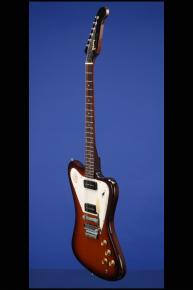Under the Bed for Forty-Nine Years!
1965 Gibson Firebird I "Non-Reverse".
This very early "non-reverse" guitar weighs just 6.90 lbs. and has a nut width of just under 1 5/8 inches and a standard Gibson scale length of 24 3/4 inches. Solid mahogany body, one-piece mahogany neck with a very fast thin-to-medium profile, and unbound rosewood fretboard with 22 jumbo frets and inlaid pearloid dot position markers. Headstock with gold-painted "Gibson" logo on black plastic truss-rod cover. Serial number ("350796") stamped on the back of the headstock. Dual-line Kluson Deluxe six-in-a-line strip tuners with oval metal buttons. Two black soapbar P-90 pickups with outputs of 8.10k and 7.90k. Three-layer (white/black/white) plastic pickguard with a "Firebird" emblem painted on in red on the upper bass side. Four controls (two volume, two tone) on the lower treble bout, plus three-way slide selector switch on the upper treble side of pickguard. Gold plastic bell-shaped knobs with metal tops. Stud bar bridge/tailpiece with pre-set ridges and factory Gibson short Vibrola tailpiece with walrus tooth tip. The pots are stamped "137 6502" (CTS January 1965). Apart from some very minor shrinkage to the pickguard just affecting two of the screw holes on the bass side and two tiny little surface marks on the top edge of the headstock, this totally original guitar is in absolutely mint (9.50) condition. One of the first of the "non-reverse" Firebirds to appear in mid to late 1965. Housed in the original Gibson rectangular black hardshell case with checkered cloth lining (9.50). With the original hang tag ("FB-I"), case keys, and bill of sale, dated July 9, 1966. This guitar can only be described as NOS (new old stock) and is most probably the finest example extant.
"Announced in Spring 1963, the original Firebird series was conceived as an attempt to produce less conventional electrics likely to appeal to Fender players. Four different models, identified by odd Roman numerals, were marketed simultaneously...The four models produced between 1963 and 1965 (a.k.a. the 'reverse' Firebirds) share the same body specifications and differ only in fretboard style, electronics and hardware...The original Firebird electrics are primarily characterized by: a neck-through-body construction; a reverse body shape with extended lower horn; a reverse peghead with the treble E tuner nearest to the nut; banjo-style tuners with rearwards buttons; and they are all equipped with mini-humbuckers built without adjustable polepieces. The early samples are characterized by a 2-piece full length neck and a convex heel where the neck blends into the body. By late 1963, production models were released with a stronger 9-piece lamination and a smaller squared-off heel. A painted-on red Firebird emblem was also added on the white pickguard...The Firebird V was the equivalent of the SG (ex Les Paul) Standard and, compared to the FBI, the model is characterized by: a bound rosewood fingerboard with trapezoid inlays; two pickups; individual volume and tone controls for each pickup; a 3-way toggle switch for pickup selection; a fully adjustable Tune-O-Matic bridge; a Deluxe Vibrola tailpiece with lyre-engraved coverplate…CMI and Gibson took the decision to discontinue the original Firebirds in early 1965 and by June a new breed of models (a.k.a. the 'non-reverse' Firebirds) was announced" (A.R. Duchossoir, Gibson Electrics -- The Classic Years, pp. 198-199).
"The Firebirds flew. They didn't soar, but they were no turkeys. Then Gibson 'fixed' them. The first fix was understandable: putting the tuners on the bass side of the headstock for easier access. But then Fender complained that the Firebird infringed on its patented offset-waist body design, so the body was changed to a non-reversed shape and made shorter and fatter-looking. The neck-through was replaced by a glued-in neck. And on the lower two models, single-coil soapbar pickups were substituted for the Firebird-style humbuckers: The only thing that was really fixed was the Firebirds' goose. They were gone by 1969" (Walter Carter, Gibson Guitars: 100 Years of an American Icon, p. 237).











